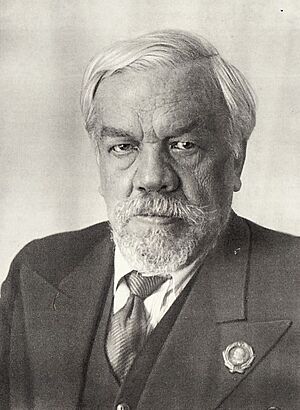Sergey Chaplygin facts for kids
Quick facts for kids
Sergey Alekseyevich Chaplygin
|
|
|---|---|
 |
|
| Born | 5 April 1869 Ranenburg, Russian Empire
|
| Died | 8 October 1942 (aged 73) Novosibirsk, Soviet Union
|
| Nationality | Russian |
| Alma mater | Moscow University |
| Known for | mechanics |
| Awards | Hero of Socialist Labour (1941) Orders of Lenin (1933, 1941) Order of the Red Banner of Labour (1927,?) Zhukovsky Prize (1925) |
| Scientific career | |
| Fields | Mechanical |
| Institutions | TsAGI, Moscow University, etc. |
| Doctoral advisor | Nikolay Zhukovsky |
| Doctoral students | Nikolai Kochin |
Sergey Alexeyevich Chaplygin (born April 5, 1869 – died October 8, 1942) was a brilliant Russian scientist. He was a physicist, a mathematician, and a mechanical engineer. He is famous for his work on how things move, especially in the air and water. You might hear his name linked to special math ideas like Chaplygin's equation or even a made-up substance in space called Chaplygin gas.
Sergey Chaplygin finished his studies at Moscow University in 1890. Later, he became a professor there. He taught engineering and math at different schools, including the Moscow Higher Courses for Women. He even became the director of these courses in 1905. One of his well-known students was Leonid I. Sedov.
Chaplygin's ideas were greatly inspired by Nikolay Yegorovich Zhukovsky, who started the Central Institute of Aerodynamics. This institute studies how planes fly. Chaplygin's early work focused on how liquids and gases move. His important writings were later collected into four books.
Contents
Sergey Chaplygin's Life Story
Early Years and Education
Sergey Chaplygin was born in a town called Ranenburg, Russia. His father was a shop assistant. When Sergey was only two years old, his father passed away. His mother then married a tradesman, and they moved to a city called Voronezh. Sergey went to school there and finished in 1886.
After school, he went to Moscow University. He studied Physics and Mathematics and graduated in 1890. At the university, he met Nikolay Yegorovich Zhukovsky, who became a big influence on him. In 1893, Sergey published his first important paper. It was about how solid objects move in liquids. For this work, he received an award.
Becoming a Professor
After graduating, Chaplygin became a professor at Moscow University. In 1897, he wrote another important paper about how a heavy spinning object moves on a flat surface. This paper introduced a new way to describe motion, which was a more general version of an older idea called Lagrange's equation. In 1899, he received a special Gold Medal from the Russian Academy of Sciences.
Later Life and Passing
Sergey Chaplygin passed away in October 1942. He died from a brain haemorrhage.
Awards and Recognition
Sergey Chaplygin received many honors for his amazing work:
- Hero of Socialist Labour (1941) – This was a very high award in the Soviet Union.
- Two Orders of Lenin (1933 and 1941) – Another very important Soviet award.
- Order of the Red Banner of Labour, twice (1927)
- Zhukovsky Prize (1925)
- N. D. Brashman Prize (1897)
Chaplygin was chosen to be a member of the Russian Academy of Sciences in 1924. This is a group of the best scientists.
To honor him, a crater on the Moon is named Chaplygin. Also, his hometown, Ranenburg, was renamed Chaplygin in his memory.
See also
- Chaplygin gas
- Chaplygin problem
- Chaplygin's equation
- Lamb–Chaplygin dipole
- Chaplygin sleigh
- Chaplygin's top

